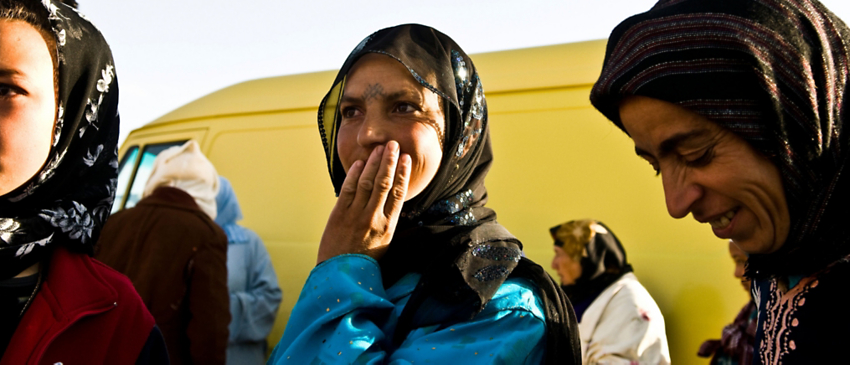Posted on 12/21/2021 12:00:00 AM in Travel Trivia

While facial tattoos are disappearing amongst younger generations of Berber women, those who still sport them today face an unfortunate stigma.
Question: In what country did facial tattoos once protect women from evil, but now mark them as sinners?
Answer: Morocco, home of the Berbers
For Amazigh (Berber) women, the price of safety and beauty was often painful: tattoos inked directly onto the face. For centuries, these tattoos defined them, but in the modern, Arab-dominated era, the tradition is rapidly disappearing. Opinions are divided over whether this is a good thing or a bad thing.
The first use of the tattooing was to ward off the jnoun (trickster, often evil, spirits, from whom we get the word “genie”). Openings in the body were seen as points of entry for the jnoun, so tattoos were placed on the face, around the eyes, mouth, and nose. There were dozens of designs, from the palm tree (symbolizing strength) to flying insects (that represented stamina and endurance), as well as abstract symbols that offered wishes for good luck or prosperity.
As the practice became more widespread, it was considered a thing of beauty and distinction. Some girls resisted—the process, after all, was inescapably painful—and only went along because their mothers and husbands insisted. Others chose the tattoos themselves, feeling like it gave them a leg up socially to be memorably adorned. Either way, it was a clear symbol of Berber heritage. Kahina, the greatest heroine of Berber myths, is often depicted with the tattoos on each cheek, which only added to the allure.
But in the Arab age, tattooing one’s face was considered less of an option than a sin. Because Islam forbids changing that which Allah has created, the tattoos were seen as affronts. Young women no longer got them; women already marked were taught to rub their silver jewelry on the tattoos and then give the silver away as penance. Within a century, the shoe was on the other foot: women who wanted the tattoos were shamed and those who did not were honored.
Today, as older generations pass, fewer and fewer tattooed faces remain. But younger women have not abandoned the patterns entirely; for important life events, they now temporarily apply the symbols with henna (which is not a sin because it will wear off). It is, in some ways, a perfect solution: the tradition is changed, not lost, and now a woman may make whichever choice she wants—without it lasting a lifetime.
10 Things to Know About Kahina: The Ultimate Berber
- In the seventh century, Kahina flouted convention and became not only a Moroccan soldier, but a commander.
- As Arab generals began to invade, she first rallied her own troops, and then convinced others from Tunisia, Algeria, and Libya to join her. Soon, she was the commander of the united armed forces.
- After she forced an Arab retreat, she was considered Queen for five years, during which she continuously led battles.
- When she was dying, she had a change of heart and instructed her sons to convert to Islam so that the Berbers could make peace with the Arabs and work side by side in the future.
- This move not only saved the Berbers but made them real partners, and Amazigh soldiers were part of the forces that conquered Spain and Portugal.
- Kahina’s foresight—and her ability to win every battle—created a legend that she was clairvoyant, which in turn led to a belief that Berber women are gifted with spiritual sight in the collective unconscious.
- In recent years, young Moroccan women fighting for more equality have often evoked Kahina, as they battle sexism that they hope will be less permanent than the tattoos of old.
See how traditions old and new come together as you meet the women of Morocco, Berber and Arab alike, on our Morocco Sahara Odyssey adventure.
The Blue City
Learn from a local about the distinctive colors of Chefchaouen, a historic Moroccan city in the Rif Mountains.
Watch Video
Destinations:
Related Trips:
Get The Inside Scoop on…
Subscribe to the Inside Scoop
Like what you see here? Receive weekly updates right in your inbox.
Sign UpArticles in this Edition
December 21, 2021
Iceland: My First International Travel Since the Pandemic
December 21, 2021
December 21, 2021
December 21, 2021
Top 15: Most Popular Adventures in Europe for 2022
December 21, 2021
We recommend upgrading your browser—simply click the button below and follow the instructions that will appear. Updating will allow you to accept Terms and Conditions, make online payments, read our itineraries, and view Dates and Prices.
To get the best experience on our website, please consider using:
- Chrome
- Microsoft Edge
- Firefox
- Safari (for Mac or iPad Devices)
We sent a confirmation email to
.
Looks like you’ve already registered with this email address.

We sent a confirmation email to
.
Looks like you’ve already registered with this email address.






